#(but man I need to practice curves more I do struggle with consistency in angles
Text
I can put my NARSTY sketches on my personal blog. Only the best of the best to put on my art blog proper. Working on hand with optional opposable of one finger, proper opposability of the other (technically have super flexible wrists too)….. and hand prints for em. Trying to ride the line between ‘biological viability’ and ‘wish fulfillment for aliens’. Kinda like the handprint having a sort of heart shape innit,,,, cause Heart is a common shape in their leaves tooo,,,,

#my arts.#gloreals.#(*chin hands* ignore the human torso attachment for one idk bout their trunk arrangement yet TRULY#(somethin much narrower than a human for sure.#(wind resistaannce they kinda Diamond shape to em#(compared to humans who I would consider more rectangular#(they’re like a front facing rectangle. while gloreals would be. Diamond with point facing forward. WIND SLIDE RIDE ON BY.#(human would be blasted out of the trees if a breeze on their planet hit em smh#(sigh my brain is so mush I know I’m messing up on the anatomy in some way but pbhghtlbh blast if I can figure#(I look at MONKEY FEETS OKAY? and the way their thumb bones CURVE MORE is what I’m lookin for#(but man I need to practice curves more I do struggle with consistency in angles#(which is kinda important to the design processsss and shape of features#(but art is the ONE THING in life you can just throw yourself at endlessly and eventually it’ll get better
2 notes
·
View notes
Text
Dark Bramble Guide [Taco Bell update]
My friend keeps getting deep space murdered so I figured I would help. Please note: I am extremely witty and hilarious and I know it.
So here’s what I’ve learned.
Dark Bramble has five SIX AUGH different openings. Four along the sides, one on “top,” and one on the “bottom.” I consider Dark Bramble to be “upright” when it is oriented like so:
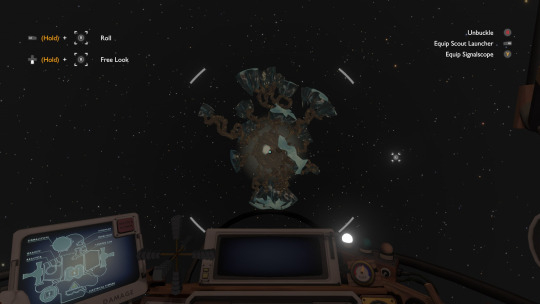
Most of the time you’re going to be dumped in front of the four middle openings, which can be the hardest to recognize if you don’t know where to look.
I’ve also determined two routes. In some cases you can get straight to the Vessel, and in others it’s better to go to the Escape Pod 3 first, and then change your marker to the Vessel (which at least gives you something to do while you’re floating past the three fish). There is ALWAYS a fish guarding a Vessel seed, but the one in the Escape Pod room is much easier to avoid aggroing as a rule.
Bear in mind that when identifying these routes, I have just shot for my targets (Escape Pod, Vessel) completely full throttle the entire time, not giving a fuck in the world, and eliminated routes that get me eaten this way. So the key to fish avoidance is to go in one direction as much as possible and avoid firing your rockets in any other directions; often I have been able to full throttle right past a fish that didn’t get upset till I fired a rocket to one side or the other.
I’ve decided to help identify these with some features I call the Dewclaw and the Forsaken Breadstick:
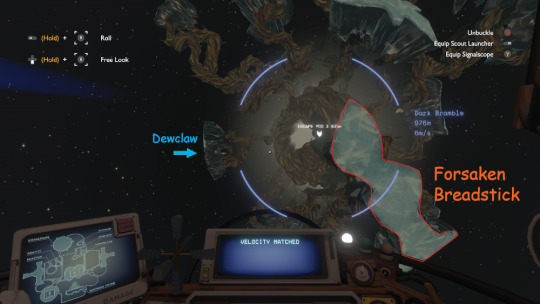

Right in between the Dewclaw and the Breadstick, we have Chili’s:

Chili’s has an Escape Pod in an ok place close by the entrance, and if you’re practicing going straight from Timber Hearth to Dark Bramble, you will always see Chili’s first. But there’s some vines and stuff in the way of the Escape Pod that make this route sub-par. There’s better places, so we’re gonna skip Chili’s. Let’s talk about Tim Hortons.

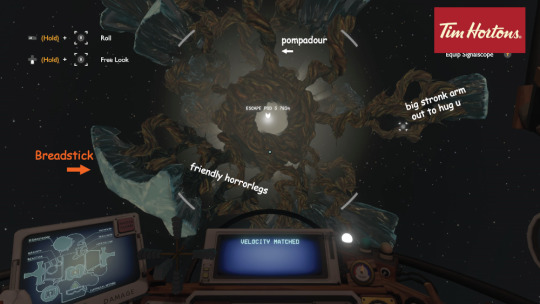
Tim Hortons is always to the right of Chili’s and the Breadstick and has the best Escape Pod route on the planet, apart from his brother Tom Hortons (who we will get to later). There’s no fish getting to the Escape Pod’s seed, it’s VERY close, and I have always avoided fish on my way to the Vessel seed from very soon after entering the room unless I was looking for a fish for Science (though there’s some annoying twisting geometry in the way if you don’t go in the direction of the Escape Pod for a bit). His Vessel route is very dangerous (2 fish yikes) and I got insanely lucky, so that’s a hard no.
This Escape Pod is the route I used to beat the game, so I’m sure it works once you have the warp core (I don’t know if more fish can spawn after you get the warp core but just in case).
Left of Chili’s, we have Olive Garden:
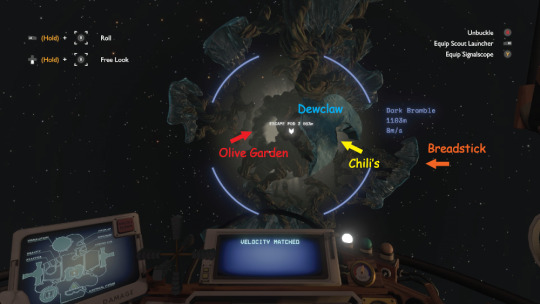

So at first I didn’t really recommend Olive Garden, because I thought the Escape Pod route was ideal and its Escape Pod will absolutely kill you. But its Vessel route is actually pretty straightforward and could actually be a winner (I had a hard time attracting the attention of its fish). It seems like Olive Garden tends to be the facing you get when you go straight from the Twins to Dark Bramble with the warp core so it’s probably the one most people naturally go into first.
To the right of Olive Garden (and left of Tim), basically in the “back” of Dark Bramble if you’re facing Chili’s like when you first arrive, there’s Tim’s brother Tom. This far around it’s hard to see our main two landmarks so here’s a newer, shittier one (sorry):
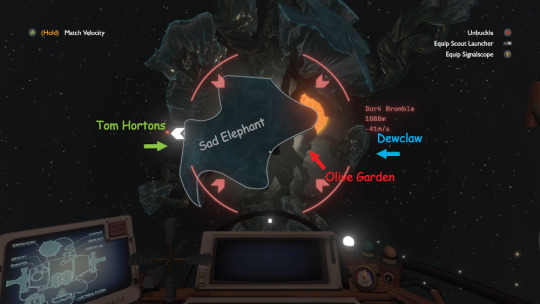

I called him Tom Hortons because at first I thought he was basically a copy of Tim’s, but Tom is actually better because Tom is an all around yes man. You want to go Escape Pod? Do it bud. Vessel seed? Yeah man. Tom’s a bro. However he is, as I discovered intensely painfully, very easy to mistake for Dark Bramble’s sixth location (the one most visible from directly on “top”), which I have decided to call Taco Bell because it is a pain in my ass:
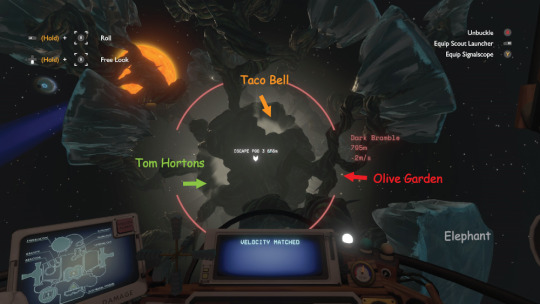
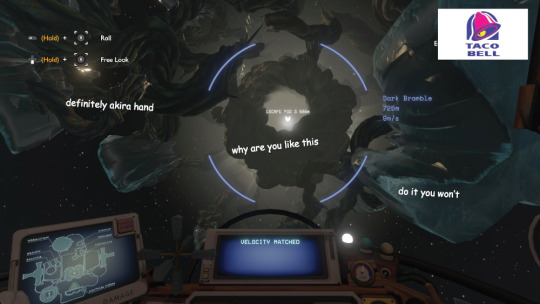
Taco Bell is kind of caged in by everybody’s sick ‘do’s and is most easily accessible from going around back of Chili’s, to either Olive Garden or Tom Hortons. It has a perfectly acceptable Escape Pod, and its Vessel seed is basically completely hit or miss. There’s a vine in front of it in some orientations, so if you go the wrong way around it there’s a Very Mad fish. So like, unless you’re aiming for an Escape Pod route, just don’t go to Taco Bell, y’know? It’s not worth it.
Finally, on the bottom, there’s Subway:

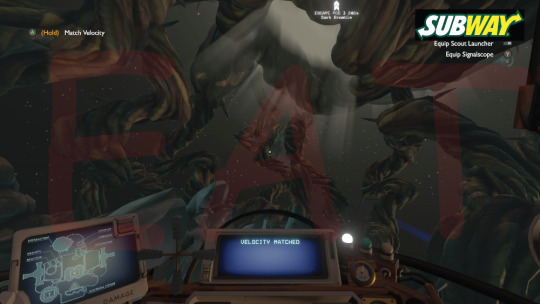
Subway is extremely easy to find because it’s on the very bottom and caged inside a bunch of vines that can be a little tricky to navigate. Also, its Escape Pod route will kill you. Its Vessel route may, potentially, also kill you--I found the fish easier to aggro--but it is very close and convenient like Olive Garden and Tom Hortons. Basically you might as well go to one of those, they’re just as close and easier on entry, but if you’re really struggling to identify them then Subway is impossible to miss. You have to want to go there.
Again, orientation is EVERYTHING in Dark Bramble, so if I say things are in the upper left/right/whatever then that’s gonna be meaningless if you approach from a different angle, but here are some outside and inside photos from the center openings as approached from an “upright” angle. This is proceeding around Dark Bramble’s center, starting from Chili’s and moving right:
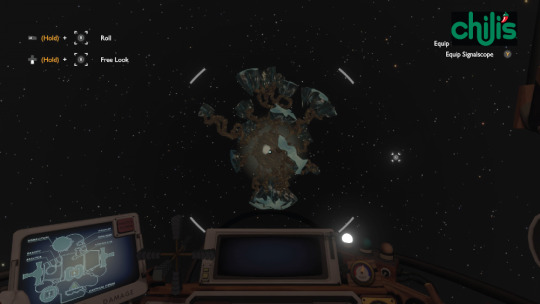



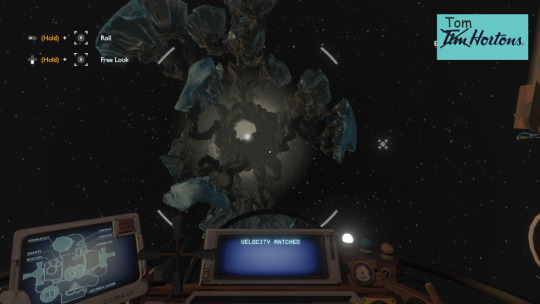

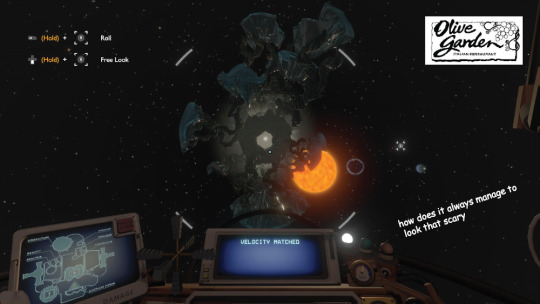

Taco Bell on top and Subway on bottom are impossible for me to give a consistent orientation for, so Subway may vary significantly from what you see depending on your angle:
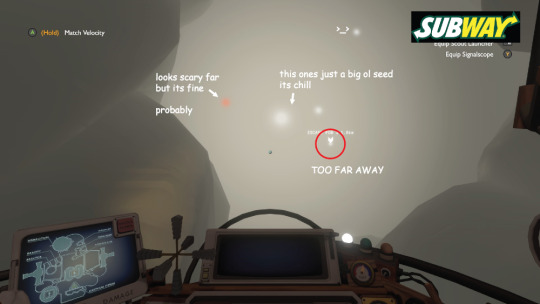
Taco Bell is a pain in the ass so it gets two of these based on which other (better) opening you face before you fly “up” over it:
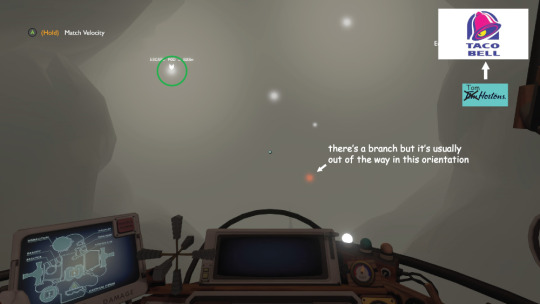

So basically, the safe Escape Pod seeds tend to be very close to the ceiling or wall and out of the way, and if the Vessel seed looks far away I’d try another entrance. From cross-referencing I have determined that a safe initial distance is usually between 1 and 1.3km, and a distance between 1.5 and 1.7km almost certainly has a fish, but again some orientations may still end up attracting attention where others would not.
Best Escape Pod Routes:
Tom Hortons
Tim Hortons
Taco Bell
Chili's (obstructed)
Best Vessel Routes:
Tom Hortons
Olive Garden
Subway
Taco Bell (obstructed)
I am pretty sure that both the Escape Pod room and the Vessel room are the same entrance flipped around different ways no matter where you enter the seed, and it’s really impossible to make the orientation consistent, but as a result both the Pod and the Vessel should be in the same place and you can navigate from there.
If you choose to take an Escape Pod route, I’d recommend aiming for the Escape Pod itself until you see a really prominent red glow from the Vessel seed. This can help you avoid all the crap floating around in the way, and it’s also completely safe once you get into the vines (I have never been eaten there from any orientation). Alternatively, following the lights to the dead Nomai also gives you a straight shot to the Vessel seed with what feels to me like the smallest possible chance of running into a fish (I think this is a gameplay mechanic), but it takes longer.
Once you actually make it into the Vessel seed DO NOT MOVE. You will not hit the fish. You cannot hit the fish. You will literally go through the fish, and then it’s ok to start accelerating up to 2 bars as long as you are under 900km away from the Vessel marker (but probably safer at under 800km). After further testing, I’m pretty sure there’s only one fish inconveniently close to the final seed, which you pass on the way. I tend to be drifting at this point to make sure I don’t slam into the branch between me and the seed, so I don’t recommend going above 1 bar around here if you can help it, the fish is more aggressive than I first thought and it’s kind of 50/50 whether he’ll actually chase you.
Fortunately, there’s a pretty foolproof direction to go in:

This last branch before the seed has a little curved area that is the perfect size for your ship, and if you go through it while still aiming for the Vessel, you will be almost perfectly lined up for an opening. (In this particular orientation I managed not to alert the fish at all, but it’s not a good idea to stop to adjust here, I’d just aim for this opening regardless.)
I think this section is kinda designed for the fish to notice you, and even if he does, you’re generally going to be close enough to the seed to make it inside before he can reach you. But sometimes he screams at me just as I’m about to go inside it even if he made no reaction before, so be prepared for that possibility.
Last tips:
-If you do attract a fish, try to put it between you and a seed. It will get slowed down or stuck in the geometry, giving you some time to go into the seed.
-If a fish groans and comes your way, stop thrusting IMMEDIATELY. If you go dark before it screams, it will go where it last heard the noise and you can coast right past. (It helps to be going at a pretty fast pace.)
-For endgame setup, I found 2:00 - 3:00 to be an optimal timing to doze off at the fire before going to Ash Twin to catch the first cycle (but that can vary across consoles/computers).
(Edit: Looks like my theme is not nice to these images so larger versions are available here if you need clearer ones, or the full guide is also up on Steam now because I am a menace.)
On a final note, Outer Wilds doesn’t care about your suffering, which is why the very first time I finally pulled out the warp core, Ember Twin got ahold of my ship and did this shit to it:

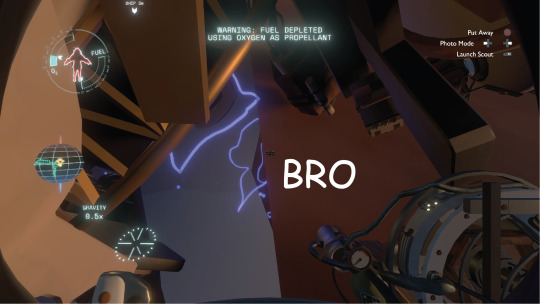
thanks for coming to my ted talk good luck with ur endless fish.
@autopotion
14 notes
·
View notes
Text
Glitch in the System - Grudgingly
The final installment of Common Ground and Can’t Catch Me. You don’t have to read them first, but you should.
A reluctant cease-fire happens.
By K.
Four o’clock crept into bed beside them with a mockingly cheery digitized ping. Widowmaker feigned ignorance of its arrival and pressed herself more firmly against the curve of Sombra’s back, burying her face between her shoulder blades.
“I do not want to,” she mumbled, lips brushing against smooth skin and scar tissue as Sombra wriggled half-consciously in her arms, struggling against both sheets and exhaustion to face her.
“Nap was a bad idea,” the hacker slurred, shoving sleep-heavy hands beneath the hem of Widowmaker’s shirt in a lazy, fumbling embrace. “Should’ve stayed awake.”
Though Venice and Fuzhou were only six hours apart in terms of time, the half-day’s flight was a slog. Talon’s operation was a particularly covert one, necessitating the use of a smaller civilian transport to avoid any unwanted attention. It could have held the pair of them and another one or two agents uncomfortably; it held them, Gabriel, Moira, and the additional six infiltration specialists only by grace of physics and flexibility alone. Between the cramped ride and the unpleasantly closer quarters of their Fujian flophouse, the trip was likely to be the more of a drain than the mission itself. When they arrived, Sombra’s suggestion they snag a brief bit of shuteye seemed fine at the time. Now, not only sore and irritated but also exhausted, it seemed very much the opposite.
“We have a half-hour,” Sombra said, a note of hope in her voice as she closed her eyes anew.
Widowmaker muffled a yawn in the other woman’s hair. “Non, cherie. Shower.”
Sombra grimaced as she offered a small, unintelligible sound of protest, something between a grunt and a whine. The sniper shook her head.
“You will be angry later if you don’t.”
“Don’t wanna’,” Sombra whined, pawing at the sniper’s back as she disentangled herself from both the hacker and the sheets. “C’me back.”
“No, you come with me,” Widowmaker chided, scooping the other woman into her arms with a tired chuckle. “This mission is going to be trash. The least we can do is look good for it.”
Sombra made a sound against her collarbone, a lone syllable of acknowledgement as much as acquiescence. “Why trash?” she managed as Widowmaker set her down on the edge of the tub. The taller woman snorted at the question, her sole response a sideways glance toward the bedroom door. Sombra nodded her immediate understanding.
“Yeah, she’s been in a shit mood.”
It had only been a handful of days since her chat with Akande and his subsequent briefing with Moira regarding the state and upkeep of her conditioning. Though Widowmaker didn’t know the particulars of that conversation, it was apparent to everyone - even her - that Moira’s regularly chilly disposition had become outright frigid as a result. For the most part, she and Sombra drank in the schadenfreude with smiles firmly lodged in the corners of their mouths; however, sharing a cramped transport with her - even in the company of others - had been unpleasant in the nicest of terms. Moira did little to hide her contempt of Akande’s decision, and the pointed glare she maintained in the sniper’s direction made it readily apparent she had every intent of making her displeasure known.
Widowmaker didn’t really care so much as find her pettiness exceptionally unbecoming.
“A mood,” she parroted, quirking an eyebrow in passive judgement, “is a word for it.”
She ascribed the root of her irritation to her not having those reflexes anymore - not in the natural sense, at least. She could be petty and take petty actions, but there was little informing such behavior beyond an self-serving want to be a thorn in another’s side - to be better, or do better, or to see another fail. She didn’t feel pettiness. Knowing Moira was choosing to stew left a sour taste in the sniper’s mouth.
“Yeah, well, she’s just pissy because you have what she couldn’t,” Sombra smirked, tugging off her shirt and tossing it in the corner of their tiny bathroom. Widowmaker tilted her head, shooting the hacker a curious glance in the mirror.
Sombra grinned, pleased as punch.
“Oh, man. I pulled some choice bits of intel from her rig; shit from her Blackwatch days and into the end of Overwatch. She definitely had something with that Ziegler lady. Got bad after the Venice blowup and the work she did on Gabe. Messy shit; ‘lack of ethics’, ‘I can’t be with someone who’d do this’ kind of shit. She doesn’t talk about it, like, explicitly, but she ain’t subtle, either.”
Widowmaker didn’t realize she was smiling until it evolved into outright laughter: part unbelieving, part relieved, and part delightfully amused. “…You think she is jealous?”
Sombra shrugged as she leaned over to grab her toothbrush, a smile tugging at the edge of her mouth. “She’s also having a weird control freak tantrum, sure, but yeah. She’s gotta’ be, even if just a little. She’s a shit, spider. Moira wants the world, and she turns into a baby when she finds something she can’t have.”
“Incroyable. I would be sad for her. If I could.”
“Eh, don’t be. She’s a grown-ass adult. With any luck, today’s the day she trips on those fucking stupid pointy shoes of hers and breaks every ankle she has. Now, help me into this shower, yeah?”
There were few joys simpler or more convenient in Widowmaker’s work than a pagoda.
Gorgeous architecture aside, all those windows made for easy tracking, which made for easy wind and velocity calculations, which made for easy sniping. Their shape nearly always necessitated the construction of a vertical perimeter, allowing her easy traversal from point to point around the building’s circumference. The only downside was her own visibility, but unpredictable and constant movement counteracted the problem well enough.
As the seventh omnic guard fell in the pagoda adjacent her position, the lights of their eyes flickering to darkness, Widowmaker smirked. She could have done this job in her sleep.
In a way, that felt very much the case. The place was practically made of glass, its interiors plainly visible even at a distance. Its courtyard entrances numbered exactly two - one northern and one southern - which made this particular perimeter a cakewalk where enforcement was concerned. If - when - law enforcement arrived, it would only become more difficult in that she’d need to move a hair faster than her already casual pace.
Luckily, fast was her forté.
“Aye, we got blues coming. ETA twelve minutes,” Sombra’s cut in over their closed communications frequency. When indeed.
“We need fifteen,” Gabriel growled. Their objective was a simple plant, albeit one with multiple targets. Another chip in the crumbling dam stemming the flood of human-versus-omnic animosity; another fuse lit in the names of conflict and evolution.
Widowmaker leaned into her weld as she picked up movement on the ninth floor. “We are secure,” she murmured, following the rapid bob of her target’s head between cubicle walls. “For now.”
Inhale. Level. Exhale. Fire.
The omnic’s cranial casing shattered outward in a burst of circuitry and metal, their body falling a mere few feet ahead of Moira as she rounded a workspace corner.
“Excellent work, Lacroix,” the geneticist observed, toeing the body aside with one pointed boot. “As always.”
“I know,” the sniper grinned.
Though Sombra passed out almost immediately upon their return to the flophouse, Widowmaker still harbored a thrum of adrenaline that left her fingers itchy and mind racing - the downside of any simple excursion. It never lasted long, but she could usually rely on wine and fresh air to assist in the suppression of that restless energy. She hadn’t brought the former; no one expected the Fuzhou mission to be so straightforward, and her expectations of any free time were accordingly minimal. The latter would have to suffice.
Locking the door behind her, Widowmaker crept quietly toward the emergency stairwell: a cramped and narrow passage lit by dim, orange bulbs she suspected hadn’t been changed in years. Their lodgings were chosen more for convenience than comfort; accordingly, luxury and even basic maintenance were secondary, if not tertiary, considerations for their current deployment. She didn’t expect anyone would want a moment’s relaxation on the building’s sun-bleached and smog-stained rooftop landing, nonetheless herself and certainly not Moira.
Yet, there she was - and there was the doctor, all elbows and angles as she leaned against the safety railing.
The sniper hesitated in the doorway, one hand lingering on the exit door’s pushbar as she considered whether to turn back. Retreat was her first and loudest instinct - not for fear, but for sheer lack of desire to engage. The part of her that understood the character and consistency of pettiness, however, beckoned her stay.
Retreat was easy. Staying was spiteful.
Widowmaker chose spite.
“Salut,” she said plainly, stepping forth from the doorway and crossing the landing. She kept a healthy distance as she joined Moira at the rooftop’s edge, leaving a few feet of comfortable, dead air between them. The doctor’s sole response was a muffled grunt, the sound toppling into the glass of neat scotch set on the railing before her.
There were no stars here to speak of; the city lights rendered the sky remained an impenetrable void of yawning off-black. Autocraft honked on the street below, the occasional laugh or clip of idle chatter sneaking through the perpetual city ambience to reach them twelve stories above. While there was likely never any real peace to be found here, Moira managed with absolutely no effort whatsoever to derail any hope for or attempt at even a moment’s peace. Widowmaker found it only appropriate she attempt the same for her.
“You are angry,” the assassin observed.
Moira glared across those few feet between them, thin lips dipping into a frown. Widowmaker refused her the courtesy of acknowledgement, leveling her gaze squarely on the city stretching before them. “You are bad at hiding it,” she added as an afterthought.
The doctor opened her mouth to speak, then closed it again as if thinking better of whatever knee-jerk reaction Widowmaker’s comment inspired. Instead, Moira deliberately returned her attention to the glass before her and lifted it to her lips. “How perceptive,” she seethed, tipping the glass back. Widowmaker watched her coolly from the corner of her eye, observed the way billboard lights bounced off sharp features while rendering others in shadow. There was an innate starkness to Moira O’Deorain that their environment only highlighted, an interplay of dark and light with very little observable graduation separating the two.
Widowmaker wondered whether Moira had ever considered the light; she wondered if the light had ever considered Moira and found her wanting. Sombra’s most recent intelligence indicated clearly it had.
“I am acknowledging you are upset,” Widowmaker tried at last. “I understand it is a kindness to do so.”
“You shouldn’t know the meaning of the word,” the geneticist snapped. “I designed you not to.”
Widowmaker finally deigned to meet Moira’s mismatched eyes, searching. There was a question in the back of her throat, clawing at her tongue: who hurt you? She knew the answer, at least on paper; but she also knew Angela Ziegler - even if only briefly - and found the potential of her doing such lasting harm to anyone unlikely. Knowing what little she did - and knowing Moira - Widowmaker suspected that it wasn’t Ziegler who’d hurt her; if anything, Moira’s own ethical failings had hurt both of them.
There it was. That was the kernel of truth she was looking for.
“Docteur,” Widowmaker began carefully, a note of hint insincere sweetness coloring her words. “Do you think you have failed?”
The taller woman narrowed her eyes. “Do not.”
Widowmaker grinned. “You do. You are upset because you think your work is, ah, imparfait.”
“It is imperfect. Clearly.”
Widowmaker laughed as Moira averted her eyes. “Akande does not think so.
“Akande’s judgement is affected by his relationship to the subject.”
“I am right here,” Widowmaker scoffed. “You are talking to me.”
Moira drained her glass and set it back down against the railing with enough force that the sniper was surprised it didn’t shatter. “And?”
“What had you hoped for?”
Moira rolled her eyes, the words falling from her mouth with precision borne of repetition. “The successful amplification of the reflexes in combination with the reduction or total elimination of neurocognitive functions which preclude the performance of an otherwise mechanically perfect killing machine: empathy, sympathy, remorse, and so forth.”
“Then you have succeeded,” Widowmaker replied casually, shrugging narrow shoulders. “I do not relate to others emotionally; I can perceive when they feel, and can sometimes guess what that feeling is based on physical cues, but I do not feel as they do out of any communal instinct. And my performance as a ‘killing machine’ is indisputable.”
It was mostly true. The details Widowmaker didn’t care to fill in were easy to omit by focusing on her relationship to Sombra. There was no reason to explain the rare echo of feeling resonating off the chasm walls which separated her mind and heart; it was irrelevant. She certainly didn’t need to mention the frequency of their occurrence.
“You are seeing Sombra; you want to convince me there is no feeling in that, Lacroix?”
Widowmaker smirked. “Only tactile ones.”
“Do not,” Moira repeated.
“You asked,” the sniper replied in cold singsong. “And I am telling. It is my hope doing so will allow you to get over yourself.”
Moira turned to face her in full this time. “Excuse me?”
“I did not stutter.”
The geneticist stepped forward, lips curled in a furious snarl that disappeared and reappeared only a few inches from the Widowmaker’s own face. Widowmaker only smiled: a cold, perfect crescent that gave the other woman pause.
“I have hit a nerve,” she noted dryly. “And I do not feel a thing about it.”
Moira hesitated, scouring the assassin’s impassive expression as if it might yield some yet unforeseen conclusion. The anger etched into the corners of her eyes faded slowly, replaced by some momentary, soft something Widowmaker couldn’t identify, but suspected was informed by memory.
“Point taken,” she huffed. “Grudgingly.”
“Bon,” Widowmaker said, turning on her heel. “I do not prefer to speak out of turn. I should like not to do it again.”
She nearly reached the door when Moira’s voice crept across the balcony, small and tired. “Lacroix.”
The sniper stopped, glancing over her shoulder and offering as much interest as a single, arched eyebrow could provide.
“I’m sorry,” she offered reluctantly.
“Accepted,” Widowmaker replied as she descended the stairs. “Grudgingly.”
*Read from the beginning or check out our intro post! All stories tagged under #glitchfic. Table of contents located here.
#spiderbyte#widowsombra#sombramaker#sombra x widowmaker#widowmaker x sombra#sombra#Olivia colomar#amelie lacroix#Amélie Lacroix#Widowmaker#moira o'deorain#Moira#Overwatch#overwatch fanfic#overwatch fandom#glitch in the system#glitchfic
32 notes
·
View notes
Text
Character Design Lesson
Assignments I’ve found online:
From Cedric’s Blog-O-Rama
Lesson 1: Fat Joe
You are to design a concept sketch of Fat Joe based on the play, The Long Voyage Home. Take it as far as you like.
Description:
SCENE—The bar of a low dive on the London water front—a squalid, dingy room dimly lighted by kerosene lamps placed in brackets on the walls At the far end of the bar stands Fat Joe, the proprietor, a gross bulk of a man with an enormous stomach. His face is red and bloated, his little piggish eyes being almost concealed by rolls of fat. The thick fingers of his big hands are loaded with cheap rings and a gold watch chain of cable-like proportions stretches across his checked waistcoat.
Lesson 2: Silhouettes
Our assignment was to take Dr. Jeckyll and Mr. Hyde, and fill a page with little thumbnail silhouettes. We were told to play with shapes, trying to find a simple and clear design for the character. The good thing about doing fast little thumbnails is it forces you to think in broad, general terms and not get hung up on the details. When you are just concerned with the overall shape, your thought process can flow and brainstorm. The goal isn’t to do terrific sketches, its to get a lot of ideas onto the paper so that later you can develop the best ones. It’s a great exercise and I highly recommend it. In the future I hope to make it part of my process when designing characters for clients projects.
Lesson 3: Portrait Study
We were given photos of four different men. First, we had to do a straight-forward sketch of the person, not really pushing the shapes or getting too cartoony. Just do a standard portrait. Then, after finishing the portrait sketch, immediately put it away and get rid of the photo. From memory, draw the person again using three different shapes: a circle, a square, and a triangle.
The goal was not to do a dead-on likeness and squeeze it into the shape, because that would be almost impossible. Rather, we were to take the features that defined that person (i.e. eyes wide apart, big chin, small pointy nose, whatever) and play with those features within the shapes to create three new characters.
Lesson 4: Jekyll and Hyde
Last week we were told to choose one of two stories (Dr. Jeckyll and Mr. Hyde, or Oliver Twist), and start thinking about designs for the main characters. Our first step was to fill up at least one page with thumbnail silhouettes of possible designs, thinking about what we could say about the character with just the overall shape. Stephen then critiqued our thumbnails and told us which ones were the strongest. As the course progresses, we will continue to develop our character(s).
Lesson 5: Hand-y Drawing Exercise
Part 1 was to sketch a page of hands.
Next to the face, the hands are the most expressive part of the body, and therefore one of the most important features in any drawing. Its easy to get lazy with the hands, because they can be so stinkin’ hard to draw. I think there are two reasons so many artists struggle:
1. Hands are incredibly complex. I think there’s something like 27 bones in the hand and 15 joints, not to mention all the little muscles, tendons, etc.
2. Hands are always moving, and they can move a zillion different ways. There is no “standard” hand pose.
Stephen spent a significant portion of his video lecture analyzing the hand and pointing out how to break it down into manageable parts to make it easier to draw. Then he told us to go draw a page of hands, using either our own hands or photos for reference.
Lesson 6: Jekyll and Hyde Clean-Up
Our assignment was to choose one design from our “Jeckyll and Hyde” work and ink it up. Inking is not my strong point, especially digital inking on the Cintiq. The Cintiq is superbly fabulous and awesome….except when it comes to inking. I just can’t seem to get the same line quality that I could on paper, which makes my lines look even more mediocre than they normally would be. Maybe I just need to practice it more.
As part of the class, Stephen gives each student one-on-one feedback on their assignments via internet video. Here’s some pointers he’s given me on my assignments, which I tried to incorporate into this final design:
• Watch out for “parallels” (lines and/or shapes in the design that run parallel to each other).
• Push your shapes more. Use more extreme angles, greater size contrasts, broader curves, etc.
• Work on thinking through the understructure of the drawing (especially in your legs and hands). Don’t just use blobby shapes, make sure there is a real skeleton with real muscles underneath.
• Keep your sizes/proportions consistent (i.e. both hands the same size, both arms the same length, etc.)
• Let your design “breathe”. Pull your arms and legs out and away from the body for clearer poses. Spread out your facial features more (I tend to bunch them up a bit).
Lesson 7: Turnarounds
This week’s assignment was to do rough turnarounds of our character.
In animation, once a character design is approved the next step is to create “turnaround” drawings. The purpose is to make sure the storybaord artists, animators, and/or computer modellers can re-create the character accurately. Turnarounds are a tedious but essential part of any character designer’s job. For major characters, there are generally four to five drawings that need to be done: Front View, 3/4 Front View, Side View, 3/4 Back View, and/or Back View. For minor characters, usually only a Front 3/4 View and a Back 3/4 View are needed.
Turnarounds can be quite challenging. It’s relatively easy to do just one drawing of a character. But drawing the same character from other angles can complicate things. The most common difficulty for the artist is making sure that the character looks appealing and consistent from all angles. Easier said than done.
Turnarounds will also reveal any flaws or weakneses in the design. You may sketch a character that looks great from the side view, but draw him again from the front view and he may suddenly flatten out and get boring.
A good designer must also think about functionality. In animation a character can have crazy proportions, but he/she must still be able to act expressively and perform common tasks. For example, did you know Charlie Brown can only touch his nose if you look at him from the front? If you look at him from the side, his arms are too short to reach around his big head.
The best way to do turnarounds is to start with a 3/4 view and then spin him around in your mind to get the other views.
Lesson 8: Attitudes and Expressions
This week’s lesson was all about model sheets, specifically attitudes and expressions.
A “model sheet” is a page of drawings that animators and storyboard artists will use as a guide when animating a character. A good model sheet will give a sense of both the personality of the character (i.e. how does he react to certain situations?) and the physicality of the character (i.e. how does he walk, move, etc.).
Our assignment was to create a model sheet for our character, consisting of two parts:
1. Six standard expressions (anger, surprise, sadness, happiness, fear, and disgust);
2. Two full-body attitude drawings, which could be whatever we wanted. The only rule was that they give a sense of the character’s personality and/or response to a given situation. I chose to depict Dr. Jeckyll before and after drinking the potion that transforms him into a big, ugly, hulking monster.
Lesson 9: The Importance of Sketchbooks
We had to go to a busy public place and fill a page with observational sketches. The Mall of America is near my house, so I went there to sketch the above page.
I can’t over-emphasize the importance of keeping a daily sketchbook. The only way to get better at drawing is to draw. As Stephen likes to say, “A page a day keeps the competition away”.
A sketchbook isn’t for polished drawings. Rather, it’s a private place where you can stay loose, experiment, stretch yourself, and make mistakes. Lots of them! (Mistakes are the best teachers). If you want to keep growing as an artist, the worst thing you can do is fill your sketchbook with things you already know how to draw.
Going to a busy place to draw real live people is something you should do regularly. (Stephen fills a page every day over his lunch hour). Most people don’t sit still for very long, so it forces you to stay loose, think fast and make bold decisions, which over time will increase your confidence. Don’t sweat the details; focus on the essence of a pose (which can usually be captured in just a few lines). Try to capture the overall physical attitude of the person, which is the foundation that breathes life into a drawing. You can always go back and flesh out the details later.
In his lecture, Stephen talked about what a character designer should focus on as he sketches the people around him (i.e. balance, gesture, line of action, negative space, rhythm, attitude, etc.) He also talked about not just seeing, but studying what you draw. Observe the different ways people walk, talk, and gesture. Notice body types, hairstyles, and clothing choices. Study how fabric clings and hangs around the body, how people position their legs when they sit, how they lean when they carry things, how their posture changes with their attitude (i.e. excited, bored, annoyed, etc.) These are the things that give your drawings personality and character.
Stephen also talked about “frankensteining”, that is, assembling parts of several people into one character. You might start to draw a man reading the paper, but as soon as you rough in his body pose he gets up to leave. Don’t abandon your drawing. Add the profile from another person, maybe the hair from a third person, etc. Frankensteining keeps you from getting frustrted when your models keep moving (or leaving) in mid-drawing, and you might be pleasantly surprised at the new character you’ve created.
The point is that you keep drawing, keep experimenting, keep learning.
Lesson 10: Memory Sketching
“Memory sketching” is an exercise designed to strengthen your observation muscles. It works like this:
Go to a place where there are a lot of people (i.e. a mall, airport, coffee shop, etc.). Choose someone in the crowd to draw. Before you pick up your pencil, spend a few moments studying everything about them (their clothing, their posture, their face, the way they do their hair, their height….everything). Don’t look at them for longer than one or two minutes. If they haven’t walked away by then, turn and face the other direction.
Now, close your eyes and continue to study them in your mind. Analyze as much as you can remember. What was that hairstyle again? How far apart were the eyes? What color were the shoes? What was with that funny walk? (Don’t peek. It will completely destroy the purpose of the exercise.)
Finally, when you’ve got your target burned into your brain and you’ve thought everything through, THEN pick up your pencil to draw. And again, no peeking.
Lesson 11: Fat Joe
Our very first assignment was to design a character based on Fat Joe from the play The Long Voyage Home. We were given this description:
SCENE—The bar of a low dive on the London water front—a squalid, dingy room dimly lighted by kerosene lamps placed in brackets on the walls At the far end of the bar stands Fat Joe, the proprietor, a gross bulk of a man with an enormous stomach. His face is red and bloated, his little piggish eyes being almost concealed by rolls of fat. The thick fingers of his big hands are loaded with cheap rings and a gold watch chain of cable-like proportions stretches across his checked waistcoat.
Now, nine weeks later, we were asked to return to that assignment and do it again, this time with clean-up and color. Since this was our last class, it was a chance to apply everything we’d learned.
0 notes
Text
Sundance 2019: The Wolf Hour, Selah and the Spades, Adam, Premature, Sister Aimee
Naomi Watts further proves that she's one of the best with "The Wolf Hour," a largely one-woman show directed by Alistair Banks Griffin that takes place in a sweaty, anxious New York City during the Summer of Sam. Watts is a major factor to the charisma of this movie, expressing her character’s isolation and anxiety; she makes each mysterious buzz on her apartment all the more nervous, and her conditions are the more visceral.
Watts plays June, an author who has essentially holed herself up in the apartment of her late grandmother. There’s an air of chaos outside, with a serial killer on the loose who terrorizes women that look just like her. Every now and then, someone mysteriously buzzes her apartment, making her all the more uncomfortable, and us too. Watts has a peacefulness when she is not disturbed, but then a vivid sense of chaos when it comes to watching the violence unfolding on the streets below her. The cinematography by Khalid Mohtaseb captures the darkness and the griminess of the apartment, ambitiously dangling the film over the edge of being too bland but finding specific light and texture to make the film visually dynamic.
Griffin's script works through a great deal of atmosphere in some of its passages, and threatens to be inert if not plotless in some passages. But it gains energy when it needs to by bringing in additional characters played by the likes of Emory Cohen and Kelvin Harrison Jr., and slowly revealing the past that has made her afraid to go outside. Watts is so strong in this part that even an exposition-heavy moment in which she watches her previous self in interview still contains nuance, mystery.
The atmospheric ambitions of the story only falter by the end, as “The Wolf Hour” doesn’t wrap itself up with brilliance in its 15 minutes. But as “The Wolf Hour” is engrossing for much of its anxious timeline, it’s the inner journey Watts provides that sticks with you most of all.
“Selah and the Spades” tells a story of high school factions, building a world out of a quintet of high school cliques in a fancy boarding school. In the style of “Dear White People” and “School Daze” before it, the story centers on a group of kids getting caught in some dirty business, and making up their own rules. Selah (Lovie Simone) is the leader of a group called the Spades, and she incorporates Paloma, a new member into her group (Celeste O'Connor), younger and more naive, but malleable. Paloma becomes our surrogate into the goings-on and the power struggles.
“Selah and the Spades” shows a great deal of promise for writer/director Tayarisha Poe, who demands your attention with style and story in her directorial debut. Some sequences can really pop, as with a center-framed monologue in which Selah talks about her agency as a cheerleader. But the inconsistent energy makes its more dialogue and plot-driven fragments about drug-dealing feel like a crash from a sugar rush.
More than its sporadic practical effects (like a stairway covered in glasses of different-colored water, or neon lights in the woods), the film’s most consistent style comes from former Ebert Fellow Jomo Fray’s cinematography. He elevates the reality of this story through tilted angles, negative space, and the center framing. It’s a great example of how cinematography can influence storytelling, and how being thoughtful with framing can affect how the overall presentation lingers.
“Adam” is a headache of a movie, however great its intentions. Here’s the pitch: a young cisgender white kid named Adam (Nicholas Alexander) goes to New York City to spend the summer with his older, queer sister Casey (Margaret Qualley), and witnesses the LGBTQ+ scene. But he pretends to be a transgender man when a queer woman (India Menuez) he’s smitten with is convinced he’s trans. We spend much of "Adam" waiting for his ridiculous, insensitive lies to be called out.
If your eyes rolled out of your head reading that, that’s fair. This premise (adapted by Ariel Schrag from her book) very likely wouldn’t work at all if it didn't prominently feature so many transgender actors, or if it hadn't been directed by a transgender director. Thankfully, this is not the mean-spirited sex comedy that could have been made from a similar concept in previous Hollywood eras. But "Adam" is a textbook example of the quandary behind progress with representation—does a movie make up for its shallow center focus by showing people on-screen who rarely get the screen-time, giving them cinematic lives? Or is “Adam” still just as bad because we spend so much of it with a nauseating protagonist?
“Adam” is given a smoothness from promising director Rhys Ernst, making his directorial debut. The film is always in control of its tone, whether it's in the studio teen comedy-esque beats, or cringing moments in which the dunderhead nonetheless learns a bit more about someone else’s life experience. But it just becomes so cringeworthy to see Adam become the main focus of the story, especially as the side characters reveal themselves to be more interesting and frustrating. Adam takes a clumsy journey to enlightenment, but at what cost? I wanted more of the characters outside of his cheap con, like his sister Casey, new confidant and Film Forum employee Ethan (Leo Sheng), temporary roommate June (Chloe Levine) and other characters who appear in the parties, clubs, and campgrounds that Adam navigates.
I have no idea who will find this movie offensive, but at the end of the day I do think the film deserves an audience—a far-reaching entity like Netflix should pick this up—so that viewers can at least see a whole bunch of actors who are talented but also gravely underrepresented in film. I can’t wait to read the critical and supportive pieces that are bound to be written about it.
“Premature” is an excellent showcase for future-star Zora Howard, who co-wrote this script with director Rashaad Ernesto Green. It largely concerns a summer in the life of Ayanna (Howard), a 17-year-old girl who is intelligent and focused, and has an electric group of friends we sporadically get to hang out with. Ayanna's life is thrown for a bit of a loop when she meets a music producer Isaiah (Joshua Boone), a slightly older man who seems worthy of her time, and quickly woos her. The film emphasizes the romance of their relationship with its Kodak 16mm cinematography, which offers a dreaminess to the scenes of them sharing intimate New York sights with each other, and a great classic grain to its flat-out sexy passages.
As the script takes place in the different days of Ayanna, sometimes it can force along its conflicts with convenient timing, like when an ex-girlfriend of Isaiah’s suddenly pops into the frame. But for the most part, the story works through some of its potential melodrama with finesse and truth, making some of its more developments feel like normal affectations of Ayanna’s most dramatic summer yet.
As it gently moves from one major life experience to the next, Green and Howard are the crucial forces that help make “Premature” feel so wise while telling its delicate story of coming-of-age. The movie gets its charisma from its lived-in moments, the scenes that are filled with her friends razzing each other, or show Ayanna finding ways to take on the world's latest curve ball. Like the love expression Ayanna later co-writes for Isaiah, “Premature” is a tender ballad—not just about love but age, opportunity, timing—that gets stuck in your head.
“Sister Aimee” is inspired by bizarre a true story, but it doesn’t take full advantage of the incredible factors within it. Anna Margaret Hollyman plays the evangelist and swindler Sister Aimee, who, as this story goes, raised a bunch of money from people by pretending to heal people, and then faked her own death in 1926. But this script from co-directors and co-writers Samantha Buck and Marie Schlingmann takes a less exciting approach to her disappearance, and reveals bits of her past in flat scenes where characters are interviewed by police. There is also a surprising focus on a badass woman named Rey (Andrea Suarez Paz), who helps Sister Aimee and her lover in their journey to Mexico, but the character details exist as if to fill in time.
There’s a lot of missed opportunity here, especially with how the story admits in opening texts that it is playing with fact and fiction. The script is more about the getaway of an enigmatic con-woman, trying to be light on its feet and dysfunctional like a Coen brothers period piece, and it just doesn’t have as much energy. "Sister Aimee" hits its desired absurdist note when Hollyman gets a song-and-dance number, but that's at the very end. But it's too late, as "Sister Aimee" is far from the film you had originally hoped it would be.
from All Content http://bit.ly/2DXCnmZ
0 notes
Text
All Tied Up
The last few weeks in mummy madness has resulted in a bit of a learning curve in the world of 'ties' notably tongue ties, upper lip ties and inner cheek ties. The formal medical term for these are frenulums which refers to tissue in the body that inhibits movement.
So this story begins with the youngest member of the hatter household struggling with reflux and constant wind pain. Our GP started treatment for the reflux using a proton pump inhibitor which has had some success. But the poor little fellow has still been in agony with wind pain and even now at 3.5 months will rarely sleep longer than a 3 hour block.
So cue our 8 week check up with the child health nurse. I raise my concerns about wind, the nurse suggests using some natural anti colic medication and seeing a lactation consultant (the little guy is exclusively breastfed). 2 weeks later, we see the lactation consultant. She does an examination of his mouth and his attachment during feeding. She notices his upper lip curling up and a clicking sound, both demonstrating he is not latching well and is essentially eating air. She believes that ties are causing issue but suggests to try chiro to see if that frees up his tongue at all and improves feeding. She also has a theory that he is filling up on air and not milk hence the sleeping issues.
After one week, three sessions of chiro and no improvement to feeding, the lactation consultant refers us to a paediatric dentist. The dentist examines young master's mouth and takes some photos. She explains that he has a posterior tongue tie, an upper lip tie and cheek ties. She also says there is other evidence that the ties are affecting feeding. My boy has a sizeable 'milk blister' on his upper lip which the dentist explains is like a callous from his lip rubbing against my skin because he keeps slipping. He also has a strong gag reflex (caused by the fact the tongue can't lift to block and protect the throat) and a build up of milk on the back of his tongue.
The dentist suggests a procedure called a frenectomy where the ties are released by being cut by a laser. She explains that the existence of tissue alone is not sufficient to warrant the procedure, but there should be an issue that needs resolving (in our case feeding) and the thickness of the tissue. The thicker the tissue the greater the restriction (not the length of the tissue which many doctors base their findings on). Other issues that can be caused by ties include tooth decay (from thick folds of skin preventing a toothbrush from accessing the tooth), bite formation (as the thick tissue can pull on the gum and cause teeth to grow at abnormal angles) and speech from being unable to open the mouth or use the tongue properly in forming words. The diagnosis and treatment of tongue ties for feeding is a relatively recent phenomena, as in the past they were only looked at if the child had speech problems. We book in the following week for the procedure - at this point young master is just over 3 months old.
Day One - Thursday
Young master has his procedure. As part of the procedure, they place goggles on his eyes (like what happens to us at the dentist so the lights do not hurt our eyes) and swaddle him. He is in the procedure room for 10 minutes total. Afterwards he feeds really well and sleeps. As predicted by the dentist, four hours post surgery he becomes irritable so we give him some panadol and nurofen and regularly repeat the dose of panadol. He seems a lot more relaxed. We start stretches six hours post surgery. They are easy enough to do but he does not enjoy them. As the day progresses, he becomes a bit lazier with his feeding and is not attaching as well and is also very gassy and distressed from that. We still do not sleep well.
Day Two - Friday
So many smiles! I have never seen this little guy smile so much. He is still a little bit lazy with his feeding but massive improvements from before. Still struggling with his wind. He has a good session with the chiro in the afternoon. The surgeon calls to check up on him and suggests maintaining pain relief. We did however manage a three and a half hour block of sleep, possibly one of the longest sleeps in a while.
Day Three - Saturday
From reports by other mums, day three is the worst post operatively. Our experience is consistent with this. Following chiro in the morning, the little guy is very distressed and unsettled most of the day between wind and pain. In the afternoon, I commence regular dosing of panadol and his mood gradually improves. His pre bedtime feed is probably his best yet (really good attachment) as are all our feeds overnight. He averages about 4 hours sleep between each feed overnight.
Day 4 - Sunday
We still continue stretches. Little man is super cuddly but on the whole seems to be feeling a lot better. His feeding really well and seems a little bit less distressed over his stretches. His wind also appears to have improved. I also notice that the milk blister on his upper lip has started to harden and reduce in size. Yay!!
So as I write this post we are still halfway through day four so I will endeavour to provide further updates as recovery continues. Interestingly, throughout this process I have discovered that there is a lot of division in the medical community about ties. When we were in hospital last week, I mentioned the wind and feeding issues to one of the paediatricians who was adamant that going to the dentist was a waste of time and his wind was from lactose intolerance. I have included an article below from the Australian Breastfeeding Association which claims that genuine lactose intolerance is extremely rare and most diagnosed intolerances are either to the cow's milk proteins or secondary intolerance. As I have already eliminated dairy from my diet under advice from GP to help his reflux (which has not seemed to have had much effect) and I rarely eat other allergens as my husband is gluten intolerant, this does not seem a likely issue. I had so many feeding issues with my first child including nipple grazing, supply issues and reflux, which are typical issues associated with ties. I wonder with better education, if I could have avoided these issues had ties been assessed and diagnosed earlier. It frustrates me to think the stress I endured may have been avoidable.
Further information
The lactation consultant directed me to the work of Dr Palmer and Dr Ghaheri - both doctors who have done extensive work and research around ties and the issues they can cause. I definitely found some interesting articles and blogs here.
The Australian Breastfeeding Association - I always find their articles very informative. I have included links to an article about ties and another about intolerances of breastmilk given how both seem to inform diagnoses of reflux and wind.
The Australasian Society for Tongue and Lip Ties. As outlined to some extent in my post above, the treatment for ties is multifaceted - we will require the support of chiro and lactation consultants going forward as my baby now needs to learn how to use his tongue properly for the first time since it developed in utero. Furthermore, the issues ties cause can require treatment by various specialists (dentists, speech therapists, orthodontists to name a few). ASTLiT endeavours to link these groups up and provide upskilling and best practice. The dentist who treated my son referred to their guidelines regarding diagnosis and stretching. I also experienced the benefit of having practitioners on the same page with the relationship between my lactation consultant, chiro and dentist.
0 notes